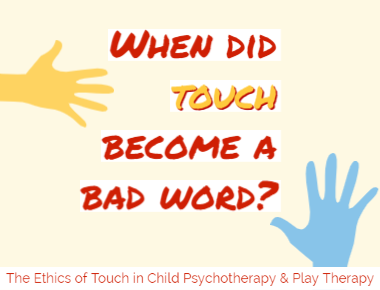10 Types of Touch That Can Happen in Therapy

In the 13th century, the Holy Roman Emperor Frederick II took 50 infants from their mothers and placed them with foster mothers. The foster mothers were instructed to feed and bathe the children, but not to touch, speak or interact with them in any other way. While his experiment was intended to discover what natural language the infants would speak, Frederick II would never find his answer because the children perished: unable to live and thrive without the clapping of hands and interaction of touch.
It should come as no surprise how crucial touch is to our development. It is the first sense that we develop in the womb, and the last sense we use before death. Knowing touch is the foundation of human experience and that it is essential for healthy growth and development, we need to pause and ask ourselves... When did touch become a bad word?
No touch rules were instituted to try to stop sexual abuse of children. These rules, while well intended, placed additional pressure on therapists, and started a new ethical battle.
Before you leave, watch this TED talk from Janet Courtney on the Curative Touch of a Magic Rainbow Hug.
It should come as no surprise how crucial touch is to our development. It is the first sense that we develop in the womb, and the last sense we use before death. Knowing touch is the foundation of human experience and that it is essential for healthy growth and development, we need to pause and ask ourselves... When did touch become a bad word?
No touch rules were instituted to try to stop sexual abuse of children. These rules, while well intended, placed additional pressure on therapists, and started a new ethical battle.
- How do you respond to a client's spontaneous hug?
- How do you ethically incorporate touch with play therapy?
- Do you need a consent form to touch your client?
- Greeting touch
- Shaking hands with child or parent
- Patterned playful touch
- Quick, synchronized hand movements (such as pat-a-cake)
- Reorienting touch
- Touching a child that appears to be drifting off
- Task-oriented touch
- Hands touch passing a toy, paper, markers, etc.
- Physical (related to an injury) touch
- A child shows you a hurt finger
- Excited/happy touch
- When a child is sharing good news
- Containment touch
- When a child is in danger (like standing on a chair)
- Intentional touch
- Measuring a child's height on the wall
- Assistance touch
- Help standing or completing a task
- Attentional touch
- When a child is touched to gain their attention about something
Before you leave, watch this TED talk from Janet Courtney on the Curative Touch of a Magic Rainbow Hug.



